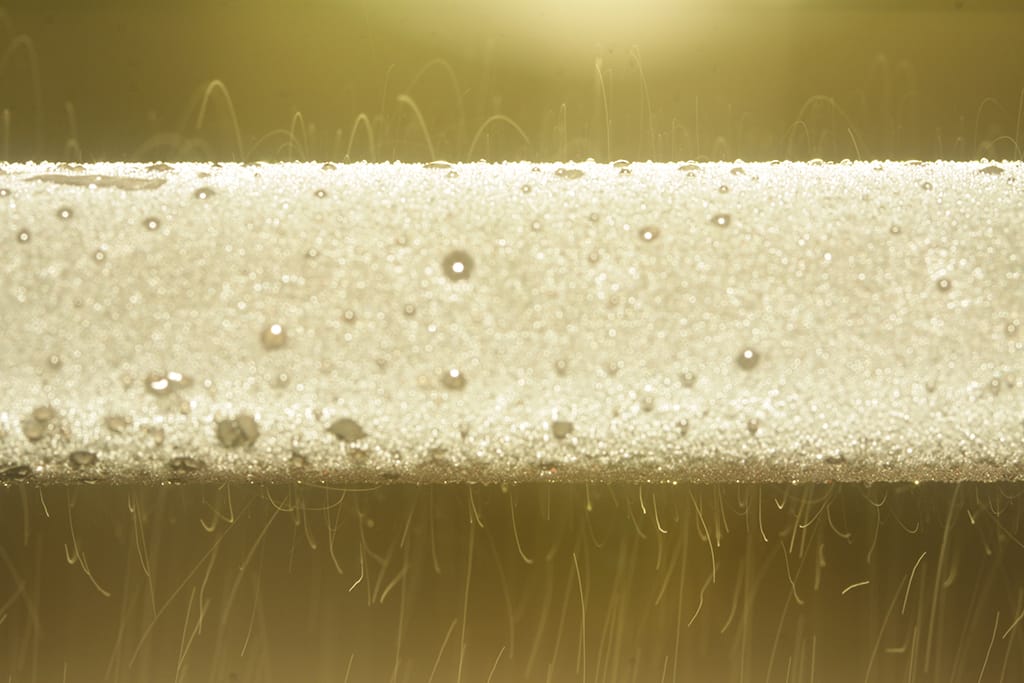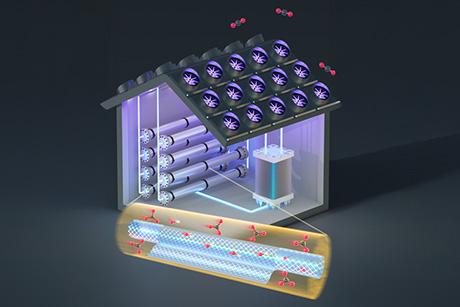Droplets get a charge out of jumping
In a completely unexpected finding, MIT researchers have discovered that tiny water droplets that form on a superhydrophobic surface, and then “jump” away from that surface, carry an electric charge. The finding could lead to more efficient power plants and a new way of drawing power from the atmosphere, they say.
The finding is reported in a paper in the journal Nature Communications written by MIT postdoc Nenad Miljkovic, mechanical engineering professor Evelyn Wang, and two others.
Miljkovic says this was an extension of previous work by the MIT team. That work showed that under certain conditions, rather than simply sliding down and separating from a surface due to gravity, droplets can actually leap away from it. This occurs when droplets of water condense onto a metal surface with a specific kind of superhydrophobic coating and at least two of the droplets coalesce: They can then spontaneously jump from the surface, as a result of a release of excess surface energy.
In the new work, “We found that when these droplets jump, through analysis of high-speed video, we saw that they repel one another midflight,” Miljkovic says. “Previous studies have shown no such effect. When we first saw that, we were intrigued.”
Droplets falling from a superhydrophobic surface are drawn toward an electrically charged wire, bottom center, demonstrating that they carry an electric charge. Video: Nenad Miljkovic
In order to understand the reason for the repulsion between jumping droplets after they leave the surface, the researchers performed a series of experiments using a charged electrode. Sure enough, when the electrode had a positive charge, droplets were repelled by it as well as by each other; when it had a negative charge, the droplets were drawn toward it. This established that the effect was caused by a net positive electrical charge forming on the droplets as they jumped away from the surface.
The charging process takes place because as droplets form on a surface, Miljkovic says, they naturally form an electric double layer — a layer of paired positive and negative charges — on their surfaces. When neighboring drops coalesce, which leads to their jumping from the surface, that process happens “so fast that the charge separates,” he says. “It leaves a bit of charge on the droplet, and the rest on the surface.”
The initial finding that droplets could jump from a condenser surface — a component at the heart of most of the world’s electricity-generating power plants — provided a mechanism for enhancing the efficiency of heat transfer on those condensers, and thus improving power plants’ overall efficiency. The new finding now provides a way of enhancing that efficiency even more: By applying the appropriate charge to a nearby metal plate, jumping droplets can be pulled away from the surface, reducing the likelihood of their being pushed back onto the condenser either by gravity or by the drag created by the flow of the surrounding vapor toward the surface, Miljkovic says.
“Now we can use an external electric field to mitigate” any tendency of the droplets to return to the condenser, “and enhance the heat transfer,” he says.
But the finding also suggests another possible new application, Miljkovic says: By placing two parallel metal plates out in the open, with “one surface that has droplets jumping, and another that collects them … you could generate some power” just from condensation from the ambient air. All that would be needed is a way of keeping the condenser surface cool, such as water from a nearby lake or river. “You just need a cold surface in a moist environment,” he says. “We’re working on demonstrating this concept.”
Jonathan Boreyko, a postdoc at Oak Ridge National Laboratory who was not connected with this research, says that while jumping droplets on superhydrophobic surfaces have been known for a few years, “the fact that the jumping droplets exhibit a net charge was completely unknown until this report. … It is my impression that this work is of very high quality and will have a large impact on the rapidly evolving field of phase-change heat transfer on nanostructured surfaces.”
The research team also included graduate student Daniel Preston and Ryan Enright, who was a postdoc at MIT and the University of Limerick and is now at Bell Labs Ireland, part of Alcatel-Lucent. The work received funding from the U.S. Department of Energy through the MIT Solid-State Solar-Thermal Energy Conversion Center, the Office of Naval Research and the National Science Foundation.



